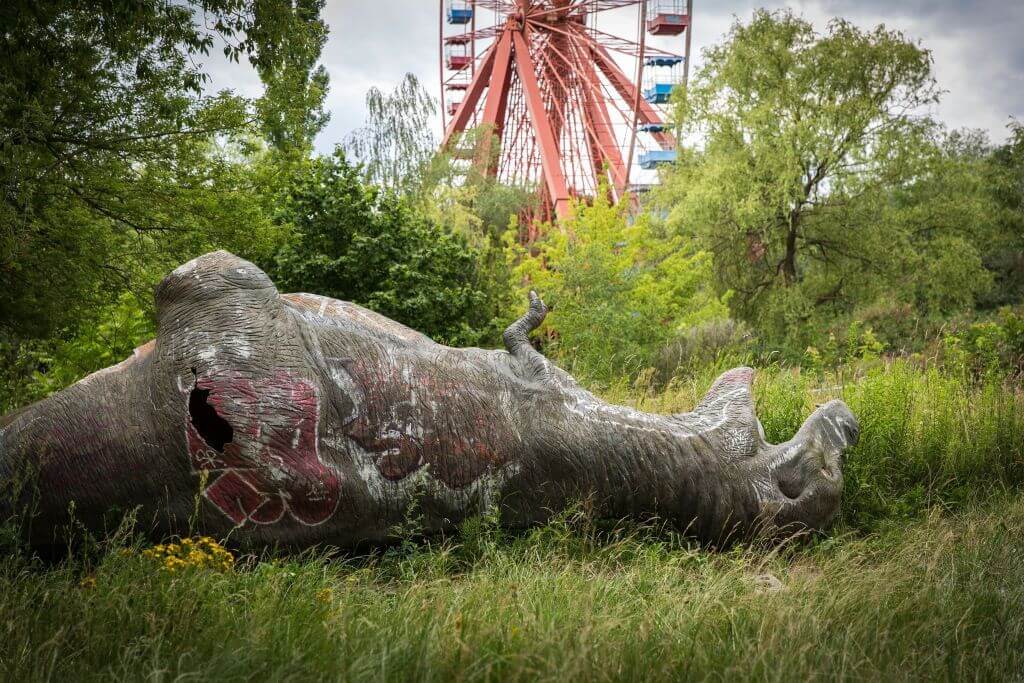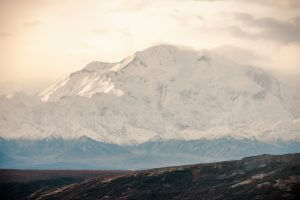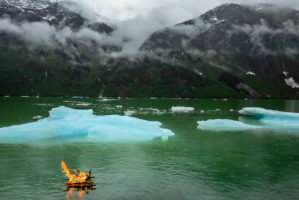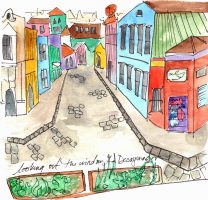Support Hidden Compass
We stand for journalism, science, history, and hope. Make a contribution to Hidden Compass and stand with us.
The park is rotting. The rapids are an empty concrete channel, the walls crumbling like stale cake. The rollercoaster rails are lost in undergrowth, and the pirate ship sits marooned and disintegrating in a green-skinned pond. It has been raining steadily for the last 72 hours; the whole park is awash with mud and gritty water. It’s miserable and eerie. It feels like the end of the world.
A headless fiberglass dinosaur, scrawled with layers of graffiti, stands at the foot of the big wheel. In the brisk wind that blows through the ruins of Berlin’s Spreepark, the wheel rotates slackly on its bearings. Its scream — metal on metal — can be heard for miles.

A fallen and broken dinosaur rests in the weeds at the abandoned Spreepark in Plänterwald. Spreepark was once East Germany’s largest amusement park. PHOTO: THIELKER / ULLSTEIN VIA GETTY IMAGES.
In 2013, a ninety-year-old woman got stuck here. She had broken into the crumbling park and climbed into one of the rainbow gondolas, only for the wind to turn the big wheel and lift her a hundred feet into the air. She spent hours up there. When she was discovered by a guard and brought safely back to earth, she apologized profusely.
“It used to be so nice here,” she said. “I just wanted to visit, one more time.”
~~
Forty years ago, the paths and plazas of Spreepark would have been heaving with people, even on a rainy day like this. Known then as the Kulturpark Plänterwald, it was the only static amusement park in the country, and at its peak a million guests visited each year. It was the era of the German Democratic Republic, also known as the communist state of East Germany, and with the borders to the west firmly closed, the Kulturpark was the only place where citizens could experience rides imported from outside the country.
Few outsiders ever visited the GDR, but those who did describe a sensation of having stepped back in time. East Berlin was quiet. Shops were sparse. Decadent Western trends like blue jeans and punk music were frowned upon. The Stasi kept watch on citizens, with cameras hidden everywhere, from bird boxes to watering cans, and leaving was an unlikely prospect. Even a jaunt into West Berlin became impossible when authorities put in place a 100-mile stretch of heavily-guarded concrete and barbed wire: the Berlin Wall.
This isn’t to say that life in the GDR was miserable. On the contrary, many look back on their years there with fondness. Life was simple. Citizens would spend time socializing, drinking coffee, sharing meals, or taking walks. There was no need to amass wealth, and many people felt as though they were part of a drive towards a socialist society that, in theory at least, was a worthy cause. Today, GDR brands that survived the arrival of capitalism are treasured by one-time citizens, for whom the sweet taste of a Halloren Chocolate Ball or a salty Spreewald Gherkin is a reminder of a place that was, faults and all, home. There’s even a name for the particular feeling of longing for the products and lifestyle of that time: ostalgia.
Within the Kulturpark, GDR citizens could seek excitement on a steel rollercoaster, or relax on a cozy vintage car ride that featured street scenes of “old Berlin.” The centerpiece was the wheel which, at 130 feet, towered above the surrounding treetops. The attractions were supplemented by shooting ranges, showgrounds, carousels, and kiosks serving almonds and other snacks. There was nothing like it anywhere else in the country. In fact, it was most similar to a theme park on the other side of the world — Disneyland.

An historic photo of patrons enjoying the Kulturpark Plänterwald in 1974. PHOTO: JOACHIM SPREMBERG.
But there were ways in which the Kulturpark was definitively unlike a western park. It once held a “socialist competition,” which bestowed a valuable TV set upon the best auto-repair shop in the country. There was a festival to celebrate the Day of the Construction Worker, where those who had helped build East Berlin were rewarded with music and dancing late into the night.
The Kulturpark also played host to traveling circuses, concerts, and even celebrations featuring overseas visitors (amongst whom, of course, “the young people of the GDR shone in magnificent national costumes”). In the winters, up to 15,000 eager guests would wait outside the gates for the Christmas markets. So popular was the park, that one correspondent for Neue Welt reported losing two buttons in the press of people surging through the gates. These events clearly brought genuine joy and happiness to GDR citizens, who visited year after year. While most could not expect to travel and see the world, they could encounter parts of it in the Kulturpark.
The park was a brave endeavor. For decades, it would remain enshrined in the memories of generations of visitors, even as its structures were devoured by changes that swept across the globe.
~~
In 1989, with Cold War tensions fading and resentment about travel restrictions on the rise, a change in policy was announced by East Berlin’s Communist Party: Citizens would be free to cross the Berlin Wall. The scenes that followed were described by one journalist as “the greatest street party the world has ever seen.” People massed at the border and streamed through checkpoints, while others attacked the wall with hammers and axes. Long-divided families were finally reunited.
Then, at exactly one minute past midnight on October 3rd, 1990, the GDR officially ceased to exist. A reunified Berlin joined the Federal Republic of Germany, and the merging of two previously-divided countries began. Many of the most treasured cultural icons of East Germany — from Trabant cars to Fillinchen crispbread — disappeared without a trace. Some did survive the transition into capitalism, however, including the Kulturpark Plänterwald. It was bought by Norbert Witte, a soft-spoken, round-shouldered showman known as the “king of carousels.”
Witte’s history was, to put it mildly, complex: his grandfather (perhaps spuriously) claimed to have been crowned king of Albania, and Norbert himself had caused the worst fairground accident in German history, when a crane he was driving smashed into a carousel, killing seven and injuring 15.
But Witte was optimistic. His goal was to upgrade the Kulturpark — now rebranded as Spreepark after the river alongside which it stood — to “Western standards” and deliver a park that could compete on Germany’s newly-opened global stage. He installed dozens of rides, from the river rapids to one of the tallest rollercoasters in the world. There were daily stunt shows, a Wild West Village, and a host of other glossy additions. Gone were the days of socialist competitions, Christmas markets and dancing.
Witte lived on site in a set of caravans with his wife and five children, for whom it was a strange but happy time. His daughter Sabrina speaks of removing electric cars from their track and racing around the park with her brother Marcel; dressing up as park mascots to entertain guests; and turning up the speed on the river rapids so that they could ride late at night.
In these happy years, visitor numbers initially soared to 1.5 million — but interest soon dwindled. With citizens now able to roam freely, the park no longer held the same appeal it once had. The rides and showgrounds that had once been a source of such joy could not compete with Germany’s exciting new world of punk music, fine dining, and international travel. Witte’s frantic expansions were unable to bring the people back — the former citizens of the GDR were forever gone.
In 2001, Witte reluctantly closed the gates of Spreepark, but his failure had just begun. With a mountain of debt on his back, he fled to Peru with his wife, children, and several flat rides. His plan was to rebuild his fortune with Lunapark, a modest fairground in front of a mall in Lima. But Witte’s family faced obstacle after obstacle, from stubborn customs officials to a lack of housing and dwindling funds. In desperation, Norbert and his son Marcel — now 21-years-old and the manager of the troubled Lunapark — turned to smuggling. In November 2003, both were arrested after more than 300 pounds of uncut cocaine were discovered inside the Magic Carpet ride as it travelled back to Germany for repairs.
Norbert was sentenced to eight years in a German prison for his crime, but served only four. Marcel fared considerably worse, being imprisoned in the infamous Sarita Colonia jail in Peru. He would barely survive 13 long years there, before finally returning to Germany in 2016 to serve out the rest of his sentence. By this time, Spreepark had been sold back to the state. The park that Marcel had last seen before leaving for Peru was now a neglected wreck of its former self, haunted by ex-citizens of the GDR who were desperate to recapture some ghost of the time in which they once lived.
~~
Spreepark is once again open to tourists. There are intermittent guided walks through its wreckage. You can take a long stroll down the wooded lane through Treptower Park, the howl of the Ferris wheel echoing through the trees around you. A huddle of guides in fluorescent jackets wait at the gate to let you in. Warning tape flutters in the breeze. Fading swan boats sit grounded in a vast, dusty warehouse. The teacup ride still rattles around on its bearings. The wheel turns very, very slowly.
Your guide may speculate about a possible future for Spreepark — as a concert venue, as a revitalized amusement park, or perhaps simply as acres and acres of housing. But looking around at the ruin that Spreepark has become, it’s hard to think of it as anything more than what it is: a marker of a singular time in history — a period that will never come again.
Krishan Coupland
Krishan Coupland earned an MA in creative writing, won the Manchester Fiction Prize, and is unduly preoccupied with theme parks.
Never miss a story
Subscribe for new issue alerts.
By submitting this form, you consent to receive updates from Hidden Compass regarding new issues and other ongoing promotions such as workshop opportunities. Please refer to our Privacy Policy for more information.



